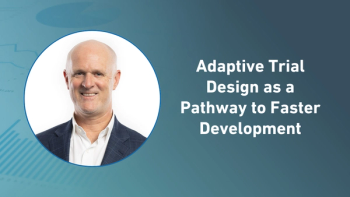
- Applied Clinical Trials-10-01-2020
- Volume 29
- Issue 10
Addressing the Needs of Clinical Trial Sites in a Post-COVID-19 World
Recognizing pre-pandemic pain points, such as patient engagement and protocol development, could lead to post-pandemic trial success.
In the face of the pandemic, more coronavirus clinical trials are being planned and initiated, while a large number of studies for non-COVID-19 indications are suffering delays. Much of the disruption can be attributed to measures taken to ensure patient safety, such as strict lockdowns and social distancing, as well as the high demand for medical professionals to treat and manage COVID-19 patients.
Across the clinical research community, we’re seeing a direct impact on trial site activation and patient enrollment. Many investigative sites are either being reallocated to assist in front-line COVID-19 care or have been temporarily closed, with much of their staff presently furloughed, making it harder for existing, pre-pandemic trials to continue. Consequently, many sponsors have implemented alternative ways to conduct trials or components of them, incorporating remote and virtual activities, which aim to bring studies directly to patients via a range of technologies.
While the pandemic has presented the industry with a host of operational challenges, COVID-19 has also given us the opportunity to reflect on how we can improve the clinical trial experience.
A focus on better understanding patients’ journeys through the clinical trial process and their interactions with investigative sites in the midst of the coronavirus crisis has prompted an important question: How can sponsors set up sites for success in a post COVID-19 world?
The answer largely lies in addressing existing pain points for investigative sites, pain points that predated the pandemic, including those around protocol development, staffing, payment schedules and, last but not least, patient engagement.
A true partnership between sponsors and investigative sites must emerge that prioritizes proactive planning and listening, enabling the development of solutions that allow critical clinical trial work to not only continue, but expand, accelerate, and thrive.
A new twist to old problems
Whether independent or an academic medical center, investigative sites have long been asking for changes to overcome the many pain points that delay or hamper clinical research. Essentially, these are old problems, but now they present themselves with a new twist because of COVID-19 and there is an impression that the issues are completely different from those clinical trial sites have always faced.
For example, sponsors notoriously leave sites out of protocol development, which we are well aware of in the industry. Every clinical investigation begins with the development of a protocol that describes how a clinical trial will be conducted—encompassing the objective(s), design, methodology, statistical considerations, and organization of the study—and ensures the safety of the trial subjects and integrity of the data collected. These documents are already quite complex, and now amid the pandemic, sites are expected to add requirements like negative COVID-19 tests as a prerequisite for patient participation and to do so without any support from trial sponsors.
Being left to navigate new requirements and complexities, and somehow still find the right patients for a clinical study is not an entirely new challenge for sites. We often hear sites say things along the lines of: “this inclusion/exclusion criteria is going to yield zero patients because we can’t find patients who meet the protocol requirements,” whether, for example, that is a specific cholesterol test or body mass index (BMI). Rather than expecting sites to just ‘figure it out” on their own, sponsors must focus on optimizing protocol design by better matching the right types of sites with the right types of studies (e.g., institutions for oncology vs. independent sites for vaccines).
Similarly, staffing challenges at clinical trial sites have always been a source of frustration, but amid the pandemic, these frustrations are being heightened. Where studies went on hold, new COVID-19 treatment and vaccine trials continue to start and, more recently, non-COVID-19 studies are ramping up again. Many independent sites, as well as academic institutions that conduct trials, suffer from staffing bottlenecks, which are intensifying because of COVID-19. For already overloaded study coordinators, who generally are without the support of a dedicated team or on-site resources, the workload has increased to a point where it has become nearly impossible to manage without additional support from service providers.
An increasing number of independent sites are offloading administrative functions so that their staff can concentrate on more clinically-focused activities. However, while independent sites are scrambling to do this quickly, larger institutions are unable to pivot and adapt at the same pace. Particularly in urban areas where hospitals are doing all they can to stay afloat, many studies have been put on the backburner and research team members, such as trial nurses, have been reassigned to help manage everyday healthcare needs, including those that involve COVID-19 triage.
That said, where staffing for clinical studies continues to be prioritized within hospital settings are cases in which research is the only care option for patients who are terminally ill, such as those enrolled in certain oncology trials.
A more nuanced impact than expected
COVID-19’s impact on clinical trial sites is much more nuanced than simply stating “the study went on hold.” A giant pain point has to do with the fact that many sites, particularly hospitals, are struggling financially. Elective and other non-essential procedures and surgeries are still a challenge to schedule and perform because of the coronavirus. This leaves hospitals and other investigative sites with the bleak reality of having to deal with reduced profitability and, consequently, furloughs, a slimmed-down staff, and even less flexibility to leverage service providers for resourcing needs.
Financial stress is a well-known challenge to clinical research site success and, again, the pandemic has simply exacerbated this pain point. Limited operating cash, manual invoicing processes, untimely payment frequency, and lack of financial transparency negatively impact site engagement and, for the most part, stem from antiquated payment terms and triggers. Investing in technologies and processes that ensure payments are accurate and on time will go a long way to resolving these issues and improving site productivity. Additionally, rather than using payment “holdbacks,” sponsors can employ alternative methods, such as better and more transparent monitoring plans to hold sites accountable for resolutions to queries.
Effectively tackling the industry-wide issue of delays in the execution of clinical trial agreements (CTAs) between sponsors or their CRO partners and sites is another measure that can be taken to meet the needs of sites in a post-COVID-19 world. Currently, we’ve seen a 10% increase globally and 13% increase in the U.S. to finalize a CTA for large research institutions. What’s interesting is that independent sites have seen a decline in the overall time of negotiations (for all trial types). Furthermore, most COVID-19 CTA negotiations are completed in less than a week, when the typical timeframe for non-COVID-19 trials can be more than three months. These differences between trial and site types need to be captured in sponsors’ templates and expectations. Standardizing legal language and streamlining the process with solutions—which address the needs of both independent sites that have limited legal resources and academic institutions more concerned with IP, indemnification, and government funding requests—would speed up study start-up by weeks, if not months.
With every challenge comes opportunity
The urgency around developing treatments and vaccines for COVID-19 has also made it clear that existing technologies can be better leveraged to address trial inefficiencies, reduce the burden on both patients and sites, and accelerate progress in clinical development. As a result of the pandemic, we will see more hybrid trials that combine site and remote patient visits. More clinical trial protocols will be written with decentralization in mind, as sponsors have now seen first-hand how positively sites have responded to working with technologies—such as telehealth tools, electronic patient-reported outcomes, and wearables, for example—that enable this approach and simultaneously reduce the burden on sites and their patients.
The decentralization of clinical trials, of course, comes along with challenges for investigative sites as well. Putting new standard operating procedures and processes in place for the conduct of remote visits adds complexity, as does incorporating and adjusting to technology designed to support them and improved patient engagement and retention. Again, at their core, these are not inherently new challenges, but the pandemic has provided an opportunity to revisit our approach to tackling pain points. In forcing the research community to be more open to using different tools to ensure vital research continues, the pandemic is driving the beginning of a new era of patient and site engagement—one in which a more proactive and efficient approach ensures the lines of communication remain open and data is collected appropriately and with greater speed.
On the flip side, sponsors will need to carefully manage which and how many technology tools they ask investigative sites to use in a given research study. Imagine a site with 10 studies from different sponsors and how many different technologies and systems they need to learn how to use in order to be successful. That problem only gets compounded as a site runs more trials for more sponsors, and some sites have as many as 400 studies ongoing at once. What it comes down to, in this case, is less is generally more. Investing in best-in-class technologies that are consistently and more commonly used across the industry, rather than customized systems, will reduce the burden on sites, especially as the disruption caused by the pandemic lessens and the volume of non-COVID-19 trials increases.
Finally, with the more open mindset the pandemic has brought about, sponsors should be more willing to use new sites for different indications. The decreasing number of primary investigators conducting research means we cannot only rely on sites we have worked with previously. Sponsors and CROs must embrace research-naïve sites in order to hit FPI (“first patient in”) and enrollment goals.
Additionally, to ensure patients in clinical trials are representative of the population, an emphasis must be placed on diversity. We know this is an issue today, so we must do all we can to introduce new sites into the mix, in locations that represent the demographic diversity of the populations we aim to serve. In doing so, we will help to move the needle and meaningfully improve outcomes for more and more patients.
Megan Trost, Vice President, WCG Study Start-Up & Administration, Lindsay McCarthy, Vice President, WCG PharmaSeek
Articles in this issue
about 5 years ago
Better Cardiac Safety Trialsabout 5 years ago
Applied Clinical Trials, October 2020 Issue (PDF)about 5 years ago
Shifting Perspectives on Site Networks to Create Positive Changeabout 5 years ago
News Notes (October)about 5 years ago
When Trials Stumble, Mobile Research Nursing Lends a Helping Handabout 5 years ago
Europe's COVID Vaccine Bids Still Veiled in Secrecyabout 5 years ago
COVID Advances Clinical Trial Transparencyabout 5 years ago
The Future of Remote Trialsabout 5 years ago
COVID-19 Highlights Need for More Diversity in TrialsNewsletter
Stay current in clinical research with Applied Clinical Trials, providing expert insights, regulatory updates, and practical strategies for successful clinical trial design and execution.






.png)



.png)



.png)
.png)
